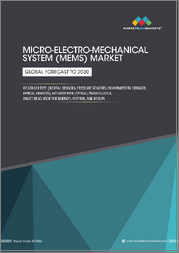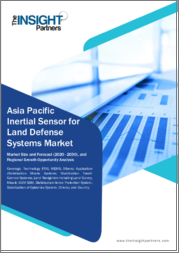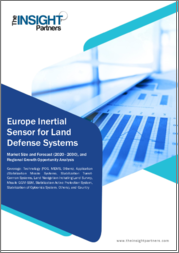
|
시장보고서
상품코드
1410083
세계 관성 센서 시장 예측(2023-2028년)Inertial Sensor Market - Forecasts from 2023 to 2028 |
||||||
세계 관성 센서 시장 규모는 2021년 112억 2,700만 달러로 평가되었습니다.
관성 센서 시장은 예측 기간 동안 강력한 성장을 보일 것으로 예측됩니다. 관성 센서는 가속도계와 자이로스코프로 구성되어 각각 비력과 회전수를 계측합니다. 관성 측정 장치는 일반적으로 3개의 가속도계와 3개의 자이로스코프를 포함하며, 모두 서로 직교합니다. 관성 센서 시장은 항공우주 및 방위, 자동차, 전기 및 전자, 기타 다양한 분야를 포함한 폭넓은 산업에 대응하고 있습니다. 관성 센서 산업의 확대를 뒷받침하는 주요 원동력은 소비자 일렉트로닉스 수요 증가와 자율 주행 차량의 성장입니다.
전자 분야의 성장이 관성 센서 시장의 성장을 뒷받침하고 있습니다.
관성 센서는 스마트폰, 태블릿, 게임기, 웨어러블, 가상현실 시스템 등의 전자 기기에 널리 사용되며 모션 감지, 제스처 인식, 이미지 안정화, 증강현실 경험 등의 기능을 실현하고 있습니다. 기술의 진보와 소비자의 선호도의 진화에 의해 소비자 일렉트로닉스 수요는 급증하고 있으며, 일렉트로닉스 생산 증가 경향은 관성 센서 산업의 성장에 직접 공헌하고 있습니다. 경제산업성(METI)에 따르면 2023년 4월 일본의 산업용 전자기기 생산은 1조1,956억 6,100만엔으로 2022년 4월부터 7.4% 증가했습니다.
신흥 자동차 산업이 관성 센서 시장 확대를 견인
관성 센서는 ESC(Electronic Stability Control), 횡전 감지, 트랙션 컨트롤, 어댑티브 헤드라이트, 차선 이탈 경고나 충돌 회피 등 ADAS(선진 운전 지원 시스템) 등에 자동차에서 사용되고 있습니다. 자동차의 안전성, 쾌적성, 자율주행 기술이 중시되게 되면서, 자동차 제조업체는 자동차에 다양한 기술 혁신을 채용하게 되어, 자동차 생산 대수의 급증이 그것을 더욱 밀어주고 있다 합니다. 국제자동차공업회에 따르면 2022년 독일 자동차 생산 대수는 11%의 대폭적인 성장을 보였으며 총 367만 7,820대에 달했습니다. 이러한 생산 대수의 급증이 자동차 분야에서 관성 센서 수요를 견인하고 있습니다.
연구개발 활동의 향상과 기술의 진보가 관성 센서 시장을 견인하고 있습니다.
관성 센서 산업의 성장은 R&D 활동의 활성화와 센서의 정확성의 진보가 견인하고 있습니다. 지속적인 R&D 활동은 관성 센서의 성능과 신뢰성 향상에 중점을 두고 있으며, 그 결과 정확성과 안정성이 향상되었습니다. 기술의 진보는 보다 정확하고 신뢰성이 높은 관성 센서 솔루션의 개발을 가능하게 하고, 항공우주, 자동차, 가전, 로봇 등 다양한 산업에의 응용 가능성을 확대합니다. 예를 들어, 2020년 Purdue University는 주파수 변조 연속파(FMCW) 라이더 기술을 활용하여 물체 검출 능력을 강화하는 연구에 주력할 것이라고 발표했습니다.
아시아태평양이 시장을 독점할 것으로 예상됩니다.
아시아태평양이 관성 센서 시장에서 큰 점유율을 차지할 것으로 예상되는 것은 이 지역의 제조업과 산업용 로봇이 활황을 보이고 있으며, 이러한 용도에서 정밀한 모션 컨트롤이나 피드백을 위한 관성 센서 수요를 자극하고 있기 때문입니다. 예를 들어 International Federation of Robotics Report 2022에 따르면 아시아는 산업용 로봇의 최대 시장으로 부상하고 있으며, 2021년 로봇 설치 대수는 38만911대로 전년 27만6,651대에 비해 38% 증가 로봇 설치 대수의 복합 연간 성장률(CAGR)은 14%입니다. 또한 인도 자동차 공업회에 따르면 인도에서는 2022년 상용차 생산량이 2021년 대비 28% 증가했습니다.
환경 요인은 관성 센서 시장의 성장을 억제합니다.
관성 센서는 가속도계와 자이로스코프를 사용하여 물체의 움직임과 방향을 측정하는 장치입니다. 그러나 이러한 센서는 성능이나 정밀도를 저하시키는 외부 영향을 면할 수 없습니다. 예를 들어 온도 변화로 인해 센서 부품이 열팽창과 열 수축을 일으켜 측정값에 드리프트나 편향이 생깁니다. 마찬가지로 진동은 센서 신호에 기계적 스트레스와 노이즈를 유발하여 데이터의 변동과 오류를 초래합니다. 정밀도가 떨어지면 구매자가 더 정밀도가 높은 센서로 이동할 수 있으므로 관성 센서 산업을 방해할 수 있습니다.
기업 제품
- 11206AC: TE Connectivity 모델 11206AC 각속도 센서는 까다로운 환경 조건에서도 정확하게 각속도를 측정할 수 있는 견고한 단축 아날로그 자이로스코프입니다. 이 센서는 완전히 캡슐화되고 보호된 전자 제품과 차폐된 22AWG 케이블을 갖춘 견고하고 컴팩트한 하우징에 포장되어 있습니다.
- LINS16488 : LINS16488은 부피가 작고 높은 과부하 내성을 가진 관성 측정 장치입니다. 정밀한 네비게이션, 제어, 무기의 동적 계측에 사용할 수 있습니다. MEMS 관성 네비게이션 시스템으로 고정밀도를 실현하고 동적 래피드 얼라인먼트를 지원합니다. 400Hz 믹스드 모드 데이터 업데이트, SPI, 1웨이 UART를 갖추고 있습니다. 이 장치는 작고 가볍고 견고하고 내구성이 뛰어납니다. ADIS16488A와 완벽하게 호환됩니다.
목차
제1장 서론
- 시장 개요
- 시장의 정의
- 조사 범위
- 시장 세분화
- 통화
- 전제조건
- 기준년과 예측년의 타임라인
제2장 조사 방법
- 조사 데이터
- 전제조건
제3장 주요 요약
- 조사 하이라이트
제4장 시장 역학
- 시장 성장 촉진요인
- 시장 성장 억제요인
- Porter's Five Forces 분석
- 업계 밸류체인 분석
제5장 세계 관성 센서 시장 : 유형별
- 소개
- 가속도계
- 압전 저항 가속도계
- 용량성 가속도계
- 압전 가속도계
- 기타
- 자이로스코프
제6장 세계 관성 센서 시장 : 측정 유형별
- 소개
- 가속도
- 진동
- 경사
제7장 세계 관성 센서 시장 : 최종 사용자별
- 소개
- 항공우주 및 방위
- 자동차
- 전기 및 전자
- 기타
제8장 세계 관성 센서 시장 :지역별
- 소개
- 북미
- 미국
- 캐나다
- 멕시코
- 남미
- 브라질
- 아르헨티나
- 기타
- 유럽
- 독일
- 영국
- 프랑스
- 스페인
- 기타
- 중동 및 아프리카
- 사우디아라비아
- 아랍에미리트(UAE)
- 기타
- 아시아태평양
- 중국
- 일본
- 한국
- 인도
- 호주
- 기타
제9장 경쟁 환경과 분석
- 주요 기업과 전략 분석
- 신흥기업과 시장수익성
- 합병, 인수, 합의 및 협업
- 벤더 경쟁 매트릭스
제10장 기업 프로파일
- TE Connectivity
- Panasonic Corporation
- Honeywell International Inc.
- ABB Ltd.
- General Electric
- TDK Corporation
- Bosch Sensortec GmbH
- INERTIAL SENSE
- Silicon Sensing Systems Ltd(Sumitomo Precision Products & Atlantic Inertial System Inc.)
The global inertial sensor market was valued at US$11.227 billion in 2021.
The inertial sensor market is anticipated to show strong growth during the forecast period. Inertial sensors consist of accelerometers and gyroscopes that measure specific force and turn rate, respectively. The inertial measurement unit typically includes three accelerometers and three gyroscopes, all mutually orthogonal. The inertial sensors market caters to a wide range of industries including aerospace and defense, automotive, electrical and electronics, and various other sectors. The increasing demand for consumer electronics and the growth of autonomous vehicles are the primary drivers propelling the expansion of the inertial sensor industry.
Growing electronics sector bolsters the inertial sensor market growth.
Inertial sensors are widely used in electronic devices such as smartphones, tablets, gaming consoles, wearables, and virtual reality systems, enabling features like motion sensing, gesture recognition, image stabilization, and augmented reality experiences. The demand for consumer electronics continues to surge, driven by technological advancements, and evolving consumer preferences, due to which the upward trend in electronics production is directly contributing to the growth of the inertial sensor industry. According to the Ministry of Economy, Trade and Industry (METI), the industrial electronic production of Japan in April 2023, stood at 1,195,661 million yen, up 7.4% from April 2022.
The emerging automotive industry drives the inertial sensor market expansion.
Inertial sensors are used in automotive for electronic stability control (ESC), rollover detection, traction control, adaptive headlights, and advanced driver assistance systems (ADAS) such as lane departure warning and collision avoidance. The increasing emphasis on vehicle safety, comfort, and autonomous driving technologies, has prompted manufacturers to adopt various technological innovations in automotive which are being further propelled by booming automotive production. According to the International Organization of Motor Vehicle Manufacturers, in 2022, Germany's automotive production witnessed a substantial 11% growth, reaching a total of 3,677,820 units. Such a surge in production is driving the demand for inertial sensors in the automotive sector.
Improved R&D activities and technological advancement drive the inertial sensor market.
The growth of the inertial sensors industry is driven by increased research and development activities and advancements in sensor accuracy. Ongoing R&D efforts are focused on improving the performance and reliability of inertial sensors, resulting in enhanced accuracy and stability. Technological advancements enable the development of more precise and reliable inertial sensor solutions, expanding their potential applications across various industries such as aerospace, automotive, consumer electronics, robotics, and more. For instance, in 2020, Purdue University announced its research focus on leveraging frequency-modulated continuous wave (FMCW) lidar technology to enhance object detection capabilities, particularly in distinguishing between moving entities and stationary objects.
The Asia-Pacific region is anticipated to dominate the market.
Asia-Pacific region will account for a significant inertial sensor market share owing to the region's booming manufacturing and industrial robotics activities which is stimulating the demand for inertial sensors for precise motion control and feedback in such applications. For example, according to the International Federation of Robotics Report 2022, Asia emerged as the largest market for industrial robots, with a record installation of 380,911 units in 2021, up 38% compared to the previous year's 276,651 units with an average annual growth rate of 14% in terms of robot installations. Moreover, according to the Society of Indian Automobile Manufacturers, in India, the output of commercial vehicles increased by 28% in 2022 compared to 2021.
Environmental factors restrain the inertial sensor market growth.
Inertial sensors are devices that measure the motion and orientation of an object using accelerometers and gyroscopes. However, these sensors are not immune to external influences that can degrade their performance and accuracy. For example, temperature changes can cause thermal expansion or contraction of the sensor components, resulting in drifts or biases in the measurements. Similarly, vibration can induce mechanical stress or noise on the sensor signals, leading to fluctuations or errors in the data. Due to the degradation of accuracy, it could hinder the inertial sensor industry as buyers might shift to more highly accurate sensors.
Key Developments
- August 2022: MEMSIC, a globally leading MEMS technology solution supplier, introduced the MIC6100AL, the first MEMS 6-axis inertial sensor (IMU). The product incorporates a 3-axis gyroscope and a 3-axis accelerometer, allowing it to enable motion-sensing interactive systems such as game controllers and smart remote controls with sensitive sensing while dramatically improving user experience. MEMSIC has a strong algorithm team to give users algorithm support that can fulfil the requirements of complex application situations.
- December 2021: MEMSENSE, the manufacturer of inertial measurement units was acquired by Inertial Labs, an industry-leading developer and supplier of orientation, inertial navigation, and optically enhanced sensor modules. Inertial Lab's strategic acquisitions bring together two high-growth firms with a track record of tackling some of the world's most complex stabilization and navigation problems.
- April 2021: A new line of compact inertial measurement units has been introduced by Honeywell that are ruggedized to provide best-in-class accuracy and the toughness to withstand high-shock settings. The new HG1125 and HG1126 inertial measurement units (IMUs), which are about the size of a water bottle cap, are inexpensive and have both industrial and military uses. By introducing the HG1125 and HG1126 inertial measurement units Honeywell continues to offer reliable and robust solutions for inertial measurements.
Company Products
- 11206AC: The TE Connectivity model 11206AC angular rate sensor is a rugged uniaxial analog gyroscope that can accurately measure angular rate under severe environmental conditions. The sensor is packaged in a tough, compact housing with fully encapsulated and protected electronics and a shielded 22 AWG cable.
- LINS16488: The LINS16488 is an inertial measurement device with a small volume and high overload resistance. It can be used for precise navigation, control, and dynamic measurement of weapons¹. The device provides high accuracy through a MEMS inertial navigation system and supports dynamic rapid alignment. It has a 400Hz mixed mode data update, SPI, and 1-way UART. The device is small in size and low in weight, solid, and durable. It is fully compatible with ADIS16488A.
Segmentation
By Type
- Accelerometers
- Piezoresistive Accelerometers
- Capacitive Accelerometers
- Piezoelectric Accelerometers
- Others
- Gyroscopes
By Measurement Type
- Acceleration
- Vibration
- Inclination
By End-Users
- Aerospace & Defence
- Automotive
- Electrical & Electronics
- Others
By Geography
- North America
- USA
- Canada
- Mexico
- South America
- Brazil
- Argentina
- Others
- Europe
- Germany
- UK
- France
- Spain
- Others
- Middle East and Africa
- Saudi Arabia
- UAE
- Others
- Asia Pacific
- China
- Japan
- South Korea
- India
- Australia
- Other
TABLE OF CONTENTS
1. INTRODUCTION
- 1.1. Market Overview
- 1.2. Market Definition
- 1.3. Scope of the Study
- 1.4. Market Segmentation
- 1.5. Currency
- 1.6. Assumptions
- 1.7. Base, and Forecast Years Timeline
2. RESEARCH METHODOLOGY
- 2.1. Research Data
- 2.2. Assumptions
3. EXECUTIVE SUMMARY
- 3.1. Research Highlights
4. MARKET DYNAMICS
- 4.1. Market Drivers
- 4.2. Market Restraints
- 4.3. Porter's Five Force Analysis
- 4.3.1. Bargaining Power of Suppliers
- 4.3.2. Bargaining Power of Buyers
- 4.3.3. Threat of New Entrants
- 4.3.4. Threat of Substitutes
- 4.3.5. Competitive Rivalry in the Industry
- 4.4. Industry Value Chain Analysis
5. INERTIAL SENSOR MARKET ANALYSIS, BY TYPE
- 5.1. Introduction
- 5.2. Accelerometers
- 5.2.1. Piezoresistive Accelerometers
- 5.2.2. Capacitive Accelerometers
- 5.2.3. Piezoelectric Accelerometers
- 5.2.4. Others
- 5.3. Gyroscopes
6. INERTIAL SENSOR MARKET ANALYSIS, BY MEASUREMENT TYPE
- 6.1. Introduction
- 6.2. Acceleration
- 6.3. Vibration
- 6.4. Inclination
7. INERTIAL SENSOR MARKET ANALYSIS, BY END-USERS
- 7.1. Introduction
- 7.2. Aerospace & Defense
- 7.3. Automotive
- 7.4. Electrical & Electronics
- 7.5. Others
8. INERTIAL SENSOR MARKET ANALYSIS, BY GEOGRAPHY
- 8.1. Introduction
- 8.2. North America
- 8.2.1. USA
- 8.2.2. Canada
- 8.2.3. Mexico
- 8.3. South America
- 8.3.1. Brazil
- 8.3.2. Argentina
- 8.3.3. Others
- 8.4. Europe
- 8.4.1. Germany
- 8.4.2. UK
- 8.4.3. France
- 8.4.4. Spain
- 8.4.5. Others
- 8.5. Middle East and Africa
- 8.5.1. Saudi Arabia
- 8.5.2. UAE
- 8.5.3. Others
- 8.6. Asia Pacific
- 8.6.1. China
- 8.6.2. Japan
- 8.6.3. South Korea
- 8.6.4. India
- 8.6.5. Australia
- 8.6.6. Others
9. COMPETITIVE ENVIRONMENT AND ANALYSIS
- 9.1. Major Players and Strategy Analysis
- 9.2. Emerging Players and Market Lucrativeness
- 9.3. Mergers, Acquisitions, Agreements, and Collaborations
- 9.4. Vendor Competitiveness Matrix
10. COMPANY PROFILES
- 10.1. TE Connectivity
- 10.2. Panasonic Corporation
- 10.3. Honeywell International Inc.
- 10.4. ABB Ltd.
- 10.5. General Electric
- 10.6. TDK Corporation
- 10.7. Bosch Sensortec GmbH
- 10.8. INERTIAL SENSE
- 10.9. Silicon Sensing Systems Ltd (Sumitomo Precision Products & Atlantic Inertial System Inc.)



















